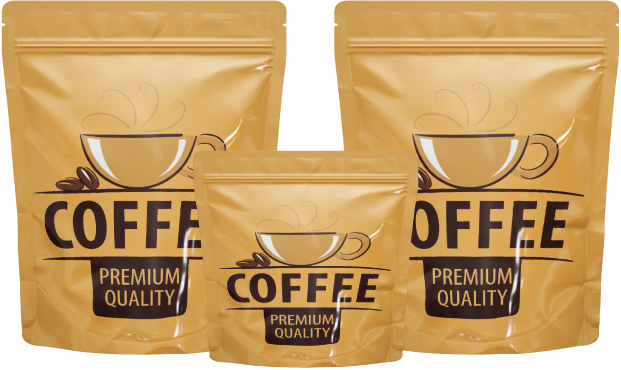Bags For Ground Coffee Packaging is a critical aspect of the coffee industry, directly influencing product quality, consumer experience, and brand identity. The right packaging not only preserves the freshness and flavor of the coffee but also plays a vital role in marketing and sustainability. This guide provides a detailed overview of the types of bags used for ground coffee packaging, the materials involved and importance.
Importance
The importance of it are as follow:
Preservation of Freshness
Ground coffee is more susceptible to losing its freshness compared to whole beans. Once coffee is ground, it has a larger surface area expose to oxygen, which can lead to faster deterioration of flavor and aroma. Hence, proper packaging is crucial to protect ground coffee from oxidation, moisture, and light.
Branding and Market Appeal
The packaging of ground coffee serves as a significant marketing tool. However, it is often the first point of contact between the consumer and the product. A well-designed bag can attract attention on store shelves, convey the brand’s message, and differentiate the product from competitors.
Convenience and Functionality
Hence, ground coffee bags must offer practical benefits for consumers. Additionaly, features such as resealable closures, easy-pour spouts, and tear notches enhance the usability of the packaging. Resealable closures help keep the coffee fresh after the bag has been opened, while easy-pour spouts and tear notches facilitate easy use.
Compliance and Information
Coffee packaging must comply with regulatory requirements and provide essential information. Hence, this includes details such as the roast date, origin of the coffee, ingredients, and brewing instructions. Accurate and clear labeling is crucial for consumer trust and regulatory compliance.
Types of Bags for Ground Coffee
The Types of it are given below:
Stand-Up Pouches
Stand-up pouches, also known as doypacks, are one of the most popular choices for ground coffee packaging. They feature a bottom gusset that allows the bag to stand upright on store shelves. This design provides excellent visibility and stability. Stand-up pouches often include features like resealable zippers and one-way degassing valves.
Flat Bottom Bags
Flat bottom bags, or box pouches, have a flat, box-like bottom that ensures stability and provides ample space for branding. Additionally, this design allows the bag to stand upright without additional support.
Side Gusseted Bags
Side gusseted bags feature gussets on both sides that expand when the bag is filled. Hence, this design allows for a larger capacity and is commonly used for ground coffee. Side gusseted bags are typically sealed at the top and bottom and can stand upright on store shelves.
Quad Seal Bags
Quad seal bags are known for their durability and strength. However, they have seals on all four corners, which help maintain the bag’s shape and prevent bulging. Hence, this type of bag is ideal for bulk ground coffee and offers a rigid, premium presentation.
Materials Used in Ground Coffee Bags
Foil Laminates
Foil laminates are widely used in ground coffee packaging due to their excellent barrier properties. They protect the coffee from oxygen, moisture, and light, which helps to preserve freshness and flavor. Foil laminates are often combined with other materials such as polyethylene to enhance their protective capabilities and provide durability.
Kraft Paper
Kraft paper is valued for its natural and rustic appearance. It is increasingly used by artisanal coffee brands to convey a sense of authenticity and quality. While kraft paper alone may not offer the best barrier properties, it is often combined with inner linings or coatings to improve its effectiveness in preserving the coffee.
Polyethylene (PE) and Polypropylene (PP)
They are commonly used plastics in coffee bags. Polyethylene is often used as an inner lining to provide moisture resistance, while polypropylene is used for its strength and durability. These materials are flexible and suitable for various bag designs, offering both protection and convenience.
Bioplastics
It is made from renewable resources such as cornstarch (PLA), are gaining popularity as sustainable alternatives to traditional plastics. Bioplastics can be compostable under certain conditions and help reduce the environmental impact of packaging.
Conclusion
bags for ground coffee packaging is a vital component of the coffee industry, affecting freshness, branding, functionality, and sustainability. As market dynamics continue to evolve, brands must navigate the complexities of material selection, design, and consumer expectations. Packaging Printing technology allows for vibrant, high-quality graphics that enhance product appeal and brand recognition.
FAQs
Why is proper packaging important for ground coffee?
Proper packaging preserves freshness by protecting coffee from oxidation, moisture, and light.
What types of bags are used for ground coffee?
Common types include stand-up pouches, flat bottom bags, side gusseted bags, and quad seal bags.
What materials are typically used in ground coffee packaging?
Materials include foil laminates, kraft paper, polyethylene, polypropylene, and bioplastics.
How can ground coffee packaging be made more sustainable?
Sustainability can be achieve through recyclable materials, biodegradable options, minimalist designs, and reusable packaging.









